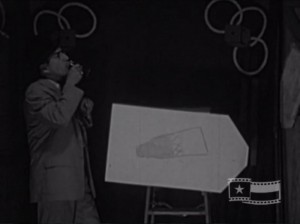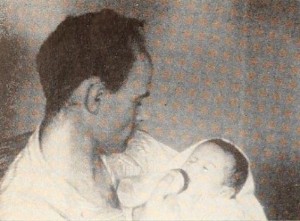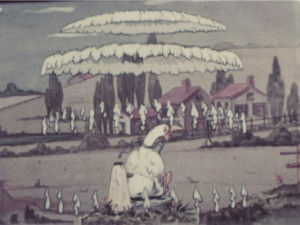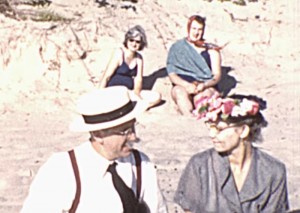"It all began when the faucet started to drip." Oldfilm.org

"This amateur film produced by longtime Austin residents Ramon and Pauline Galindo, features Ramon performing illusions with alcohol. As Ramon proceeds to get drunk, the illusions become more compelling" Texas Archive of the Moving Image.
The Drunk Act was produced at some time in the 1950s.

"Here, in Duck Soup, is the true life blood of amateur movie making — the family film. Since the hobby's very beginning in 1923, and consistently through the years since that time, more persons have bought more amateur movie cameras to take family films than for all other reasons put together. And yet look at the results! Or better still, don't look at them — for they are on the average an incoherent hodgepodge of over and underexposure, unsteady camera handling and wild panning on disconnected mementos of familiar milestones. Duck Soup, for those filmers who are lucky enough to see it, should change all that. For here is a well planned and crisply executed family film which has a beginning, a middle and an end. It has also precise camera work, fluid sequencing, and lighting on the children which will delight the heart of all home filmers. Do not, however, let these disciplined excellencies mislead you. For, above all else, Duck Soup is no stodgy exercise in family record keeping. These people had fun! Look . . . Duck Soup is a rollicking, rambunctious saga of what happens in a household when Pop, charging recklessly that the trials of homekeeping are "duck soup," is deserted for a few days by his deserving wife. What happens, as Pop gets the works from a quintet of utterly engaging youngsters, shouldn't happen (as they say) to a dog. There is stolid, well-meaning Tim, who, returning from the corner store, mangles a loaf of bread beyond all human use; there is demure and lovely Ellen, who plays the bride with Mom's best lace tablecloth; there are Greg and Kevin, impish and angelic twins, who roughhouse their way through the afternoon nap, bathing, haircuts and countless other high-spirited adventures. And there is, finally, Gary, the baby, who bawls like a foghorn and is Pop's particular problem-of-the-day. Duck Soup, in recounting these hilarious misadventures, is not a "great" film in the majestic sense of the word. (Majesty would be impossible in the face of that Lawler brood!) But it is family filming of the finest sort. It is warm, winning and alive with good spirits. Duck Soup is the best of the Ten Best for 1952 — and it richly deserves the Maxim Memorial Award which it has won." Movie Makers, 1952, 323-324.

"To the producer of Ducky 'n Busty must be given the palm of accomplishment for making the first 16mm. cartoon story in Kodachrome that has come to the attention of the League. Plenty of publicity has been given to the immense amount of detailed work that goes into making a theatrical screen cartoon. In Hollywood, this is done by a large staff, but Emile Gallet, producer of this unusual film, performed every bit of the work himself. This included the construction of a special apparatus for shooting color film, frame by frame, the arrangement of proper lighting and designing an alignment device for bringing each separate drawing into correct relationship with its predecessor. In addition, Mr. Gallet, who is an artist, planned the scenario and executed each separate drawing in color. The monumental effort thus involved may be deduced from the fact that there are forty frames to each foot of film and that Ducky 'n Busty runs to a length of 400 feet. The subject matter of this amusing cartoon is of the type familiar in theatrical productions, wherein the antics of birds and animals repeat the foibles of humankind. In imaginative color design, fine technical work and sheer achievement in this field, into which so few amateur workers have ventured, Mr. Gallet rates highest praise." Movie Makers, Dec. 1937, 629.
documentario/documentary (title may be a play with il duce)
"a soggetto breve"/short fiction
"Footage captured by cinephotographer George Sewell, showcasing the results achieved using Dufaycolor film stock." (EAFA Database)
"Structurally sustained by only the slimmest of plot incidents, Dummy Walks Out is in essence an etude in cinematics, sparkling with brilliant photography and bravura with striking angles. An evening of bridge, consistently bad cards to one player and, in time, the dummy walks out — such is the simple scheme of this masterpiece in miniature. Throughout its brief footage, however, the producers, M. P. Gamber. ACL, and Walter Mills, ACL, have contrived a gleaming glossary of cinematic imagination which delights the eye and beggars analysis. Near shot, closeup and extreme closeup (in several scenes, a single playing card fills the entire screen) follow one another with graphic beauty. Dummy Walks Out is a brilliant answer to the timid souls who "alibi" that the Eights can't take it." Movie Makers, Dec. 1935, 534, 550.

An elderly couple visits the beach, where they observe young people engaged in sports and romance. These sights prompt the couple to reflect on the story of how they met at the same beach in their younger years.
"Autumn...Frost Country and Dunes both films made by David Adams of Santa Monica, Calif. rated high in the Class "C" list of winners. Both in color with optical sound. "Autumn...Frost Country" is an 8-minute film of changing leaves narrated with a poem written and recited by Robert Frost. "Dunes" is a 7-minute film depicting the vastness of the desert at Death Valley. The film does an excellent job of conveying the fact that, in spite of the soltitude of the desert, there is plenty of life to be observed there if one has patience," PSA Journal, Mar. 1970, 43.
Total Pages: 299